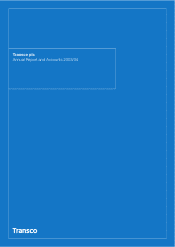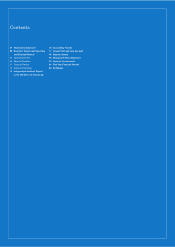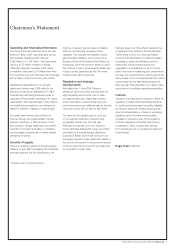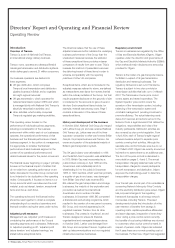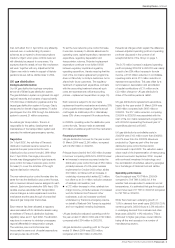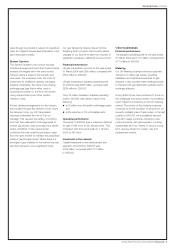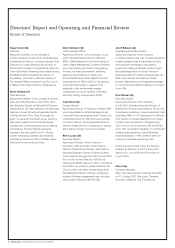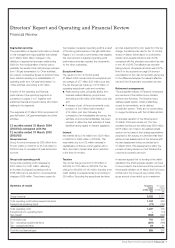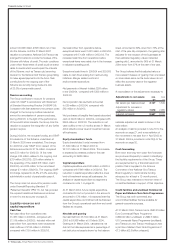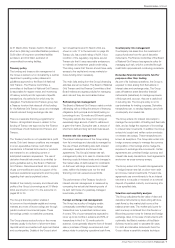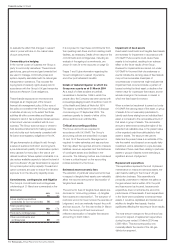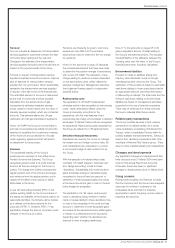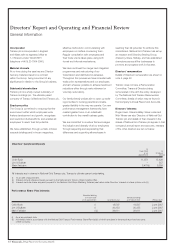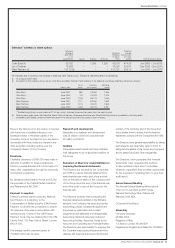National Grid 2004 Annual Report Download - page 11
Download and view the complete annual report
Please find page 11 of the 2004 National Grid annual report below. You can navigate through the pages in the report by either clicking on the pages listed below, or by using the keyword search tool below to find specific information within the annual report.
Financial review_continued
At 31 March 2004, Transco had £0.76 billion of
short-term (364 day) committed facilities (undrawn),
£0.58 billion of long term committed facilities
(undrawn); and £0.9 billion (undrawn) of
uncommitted borrowing facilities.
Treasury policy
The funding and treasury risk management of
the Group is carried out on its behalf by a central
department operating under policies and
guidelines approved by the Board of National
Grid Transco. The Finance Committee, a
committee of the Board of National Grid Transco,
is responsible for regular review and monitoring
of treasury activity and for approval of specific
transactions, the authority for which may be
delegated. The National Grid Transco group has
a Treasury function that raises all of the funding
for the National Grid Transco group and manages
interest rate and foreign exchange rate risk.
There is a separate financing programme for
Transco. All significant issues in relation to the
funding of Transco are approved by the Finance
Committees of both National Grid Transco and
Transco.
The Treasury function is not operated as a profit
centre. Debt and treasury positions are managed
in a non-speculative manner, such that all
transactions in financial instruments or products
are matched to an underlying current or
anticipated business requirement. The use of
derivative financial instruments is controlled by
policy guidelines set by the Board of National
Grid Transco. Derivatives entered into in respect
of gas commodities are used in support of the
business operational requirements and the policy
regarding their use is explained below.
Details of the maturity, currency and interest rate
profile of the Group’s borrowings as at 31 March
2004 are shown in note 17 to the accounts on
pages 28 to 30.
The Group’s financial position enables it
to borrow on the wholesale capital and money
markets and most of its borrowings are through
public bonds and commercial paper. These
borrowings contain no restrictive covenants.
The Group places surplus funds on the money
markets usually in the form of short term fixed
deposits which are invested with approved banks
and counterparties. Details of the Group’s short
term investments as at 31 March 2004 are
shown in note 17 to the accounts on page 29.
Transco plc has a credit rating of A2/A. It is a
condition of the regulatory ring-fence around
Transco plc that it uses reasonable endeavours
to maintain an investment grade credit rating.
This rating means that Transco should have ready
access to the capital and money markets for
future funding when necessary.
The main risks arising from the Group’s financing
activities are set out below. The Board of National
Grid Transco and the Finance Committee of that
Board reviews and agrees policies for managing
each risk and they are summarised below.
Refinancing risk management
The Board of National Grid Transco mainly controls
refinancing risk by limiting the amount of financing
obligations (both principal and interest) arising on
borrowings in any 12-month and 36-month period.
This policy restricts the Group from having an
excessively large amount of debt to refinance in
a given time-frame. During the year, a mixture of
short term debt and long term debt was issued.
Interest rate risk management
The interest rate exposure of the Group arising
from its borrowings and deposits is managed by
the use of fixed and floating rate debt, interest
rate swaps, swaptions and forward rate
agreements. The Group’s interest rate risk
management policy is to seek to minimise total
financing costs (ie interest costs and changes in
the market value of debt) subject to constraints
so that even with large movements in interest
rates, neither the interest cost nor the total
financing cost can exceed pre-set limits.
The performance of the Treasury function in
interest rate risk management is measured by
comparing the actual total financing costs of
its debt with those of a passively-managed
benchmark portfolio.
Foreign exchange risk management
The Group has a policy of hedging certain
contractually committed foreign exchange
transactions over a prescribed minimum size.
It covers 75% of such transactions expected to
occur up to six months in advance and 50% of
transactions in the 6 to 12 month period in
advance. Cover generally takes the form of forward
sale or purchase of foreign currencies and must
always relate to underlying operational cash flows.
Counterparty risk management
Counterparty risk arises from the investment of
surplus funds and from the use of derivative
instruments. The Finance Committee of the Board
of National Grid Transco has agreed a policy for
managing such risk, which is controlled through
credit limits, approvals and monitoring procedures.
Derivative financial instruments held for
purposes other than trading
As part of its business operations, the Group is
exposed to risks arising from fluctuations in
interest rates and exchange rates. The Group
uses off-balance sheet derivative financial
instruments (derivatives) to manage exposures
of this type and, as such, they are a useful tool
in reducing risk. The Group’s policy is not to
use derivatives for trading purposes. Derivative
transactions can, to varying degrees, carry both
counterparty and market risk.
The Group enters into interest rate swaps to
manage the composition of floating and fixed rate
debt, and so hedge the exposure of borrowings
to interest rate movements. In addition the Group
enters into bought and written option contracts
on interest rate swaps. These transactions are
known as swaptions. The Group also enters into
foreign currency swaps to manage the currency
composition of borrowings and so hedge the
exposure to exchange rate movements. Certain
agreements are combined foreign currency and
interest rate swap transactions. Such agreements
are known as cross-currency swaps.
The Group enters into forward rate agreements
to hedge interest rate risk on short-term debt
and money market investments. Forward rate
agreements are commitments to fix an interest
rate that is to be paid or received on a notional
deposit of specified maturity, commencing at a
future specified date.
Valuation and sensitivity analysis
The Group calculates the fair value of debt and
derivative instruments by discounting all future
cash flows by the market yield curve at the
balance sheet date. The market yield curve for
each currency is obtained from the Reuters or
Bloomberg screen notes for interest and foreign
exchange rates. In the case of instruments with
optionality, the Black’s variation of the Black-
Scholes model is used to calculate fair value.
For debt and derivative instruments held, the
Group utilises a sensitivity analysis technique
Annual Report and Accounts 2003/04_Transco plc 9

